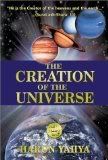The Fine Tuning in the Universe
 By Harun Yahya
By Harun Yahya
(He Who created the seven heavens in layers. You will not find any flaw in the creation of the All-Merciful. Look again—do you see any gaps? Then look again and again. Your sight will return to you dazzled and exhausted! ) (Qur’an, 67:3-4)
( He to Whom the kingdom of the heavens and the earth belongs. He does not have a son and He has no partner in the Kingdom. He created everything and determined it most exactly. ) (Qur’an, 25:2)
Materialist philosophy emerged with the claim that all the systems in nature and the universe were like machines that functioned on their own, that the flawless order and balance within them were the work of chance. However, today, the false nature of materialism and of Darwinism, its so-called scientific foundation, has been scientifically demonstrated.
The scientific discoveries of the 20th century that followed swiftly, one after the other, in the fields of astrophysics and biology have proved that life and the universe were created. As the theses of Darwinism collapsed, the Big Bang theory has shown that the universe was created from nothing. Discoveries have revealed that there is a great design and fine-tuning in the material world and this has categorically demonstrated the groundless nature of the claims of materialism.
Considering the conditions necessary for life, we see that only the Earth meets these particular conditions. For an environment suitable for life, there are innumerable conditions taking place simultaneously and unceasingly all around us. There are some hundred billion galaxies, each with—on average—a hundred billion stars.1 In all the galaxies, there are perhaps as many planets as stars. In the face of such overpowering numbers, one can better comprehend the significance of the formation of such an exceptional environment on the Earth. 
From the force of the Big Bang explosion to the physical values of atoms, from the levels of the four basic forces to the chemical processes in the stars, from the type of light emitted by the Sun to the level of viscosity of water, from the distance of the Moon to the Earth to the level of gases in the atmosphere, from the Earth’s distance from the Sun to its angle of tilt to its orbit, and from the speed at which the Earth revolves around its own axis to the functions of the oceans and mountains on the Earth: every single detail is ideally suited to our lives. Today, the world of science describes these features by means of the concepts of the “Anthropic Principle” and “Fine-Tuning.” These concepts summarise the way that the universe is not an aimless, uncontrolled, chance collection of matter but that it has a purpose directed towards human life and has been designed with the greatest precision.
Attention is drawn in the above verses to the measure and harmony in Allah’s creation. The word “taqdeeran,” meaning “to design, measure, create by measuring,” is employed in Qur’anic verses such as Surat al-Furqan 2. The word “tibaqan,” meaning “in harmony,” is used in Surat al-Mulk 3 and Surah Nuh 15. Furthermore, Allah also reveals in Surat al-Mulk with the word “tafawutin,” meaning “disagreement, violation, non-conformity, disorder, opposite,” that those who seek disharmony will fail to find it.
The term “fine-tuning,” which began to be used towards the end of the 20th century, represents this truth revealed in the verses. Over the last quarter-century or so, a great many scientists, intellectuals and writers have shown that the universe is not a collection of coincidences. On the contrary, it has an extraordinary design and order ideally suited to human life in its every detail. Many features in the universe clearly show that the universe has been specially designed to support life. The physicist Dr. Karl Giberson expresses this fact thus:
In the 1960s, some physicists observed that our universe appears to have been fine-tuned for the existence of human life. 2
The British astrophysicist Professor George F. Ellis refers to this fine-tuning in these terms:
Amazing fine tuning occurs in the laws that make this [complexity] possible. Realization of the complexity of what is accomplished makes it very difficult not to use the word “miraculous” without taking a stand as to the ontological status of the word. 3
Gravity:
- If gravity were stronger, excessive ammonia and methane would collect in the Earth’s atmosphere, which would have a most damaging effect on life.
- If it were weaker, the Earth’s atmosphere would lose excessive quantities of water, making life impossible.
The Earth’s Distance from the Sun:
- If this were any greater, the planet would grow very cold, the water cycle in the atmosphere would be affected, and the planet would enter an ice-age.
- If the Earth were any closer to the Sun, plants would burn up, the water cycle in the Earth’s atmosphere would be irreparably damaged, and life would become impossible.
The Thickness of the Earth’s Crust:
- If the crust were any thicker, then an excessive amount of oxygen would be transferred to it from the atmosphere.
- If it were any thinner, the resulting amount of volcanic activity would make life impossible.
The Speed at which the Earth Revolves:
- If this were any slower, the temperature difference between day and night would grow enormously.
- If it were any faster, then atmospheric winds would reach enormous speeds, and cyclones and storms would make life impossible.
The Earth’s Magnetic Field:
- If this were any more powerful, very strong electromagnetic storms would arise.
- If it were any weaker, then the Earth would lose its protection against the harmful particles given off by the Sun and known as solar winds. Both situations would make life impossible.
The Albedo Effect (Ratio between the amount of light the Earth reflects and the amount of light that is absorbed):
- If this were any greater, an ice-age would rapidly result.
- If it were any less, the greenhouse effect would lead to excessive warming. The Earth would first be flooded with the melting of the glaciers, and would then burn up.
The Proportion of Oxygen and Nitrogen in the Atmosphere:
- If this were any greater, vital functions would be adversely accelerated.
- If it were any less, vital functions would adversely slow down.
The Proportion of Carbon Dioxide and Water in the Atmosphere:
- If this were any greater, the atmosphere would overheat.
- If it were any less, the temperature of the atmosphere would fall.
The Thickness of the Ozone Layer:
- If this were any greater, the Earth’s temperature would fall enormously.
- If it were any less, the Earth would overheat and be defenceless against the harmful ultraviolet rays emitted by the Sun.
Seismic Activity (Earthquakes):
- If this were any greater, there would be constant upheaval for living things.
- If it were any less, the nutrients at the sea bottom would fail to spread into the water. This would have a damaging effect on life in the seas and oceans and all living things on Earth.
The Earth’s Angle of Tilt:
The Earth has a 23 degree angle of inclination to its orbit. It is this inclination that gives rise to the seasons. If this angle were any greater or any less than it is now, the temperature difference between the seasons would reach extreme dimensions, with unbearably hot summers and bitterly cold winters.
The Size of the Sun:
A smaller star than the Sun would mean the Earth would freeze and a larger star would lead to its burning up.
The Attraction between the Earth and the Moon:
- If this were any greater, the powerful attraction of the Moon would have extremely serious effects on atmospheric conditions, the speed at which the Earth revolves around its own axis and on the ocean tides.
- If it were any less, this would lead to extreme climate changes.
These are just a few of the exceedingly sensitive balances which are essential for life on Earth to have emerged and to survive. Yet even these are sufficient to definitively reveal that the Earth and the universe could not have come into being as the result of a number of consecutive coincidences. The concepts of “fine-tuning” and the “anthropic principle” that began to be employed in the 20th century are further evidence of Allah’s creation. The harmony and proportion therein were described with magnificent accuracy fourteen centuries ago in the Qur’an.
1- Carl Sagan, Cosmos (Avenel, NJ: Wings Books: April 1983), 5-7.
2- Karl Giberson, “The Anthropic Principle,” Journal of Interdisciplinary Studies 9 (1997).
3- George F. Ellis, "The Anthropic Principle: Laws and Environments,” The Anthropic Principle, F. Bertola and U. Curi (New York: Cambridge University Press: 1993), 30.




























No comments:
Post a Comment